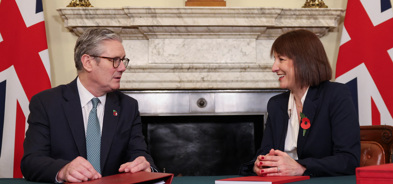Markets were back to risk-off mode – weekly update 7 January
A look back over macroeconomic and market events for the week ending 4 January 2019.
The value of investments can fall as well as rise and that you may not get back the amount you originally invested.
Nothing in these briefings is intended to constitute advice or a recommendation and you should not take any investment decision based on their content.
Any opinions expressed may change or have already changed.
Written by Ben Seager-Scott
Published on 07 Jan 201911 minute read

A look back over macroeconomic and market events for the week ending 4 January 2019. Markets remained volatile into the end of 2018 and started 2019 on uncertain ground. The Federal Reserve (Fed) hiked interest rates at its final meeting of 2018 and now seem likely to pause, whilst economic data continue to be mixed. The week is fairly quiet for data, but the Fed’s minutes will be of interest and politics gets back into full swing.
Far from relaxed for US markets and economics
It has been a far from relaxed few weeks for US markets and economics, with a partial government shutdown and dovish rate hike. Without a resolution to fund Donald Trump’s border wall/fence/barrier with Mexico, the political stand-off led to a partial shutdown of the Government, starting just before Christmas and which remains in effect at the time of writing, although there are efforts by the newly installed Democratic majority in the House of Representatives to find a way to end the shutdown.
Away from party politics to monetary policy, and the Fed increased interest rates a quarter point at its final meeting, leaving the new range at 2.25-2.50%. Implied probabilities favoured this outcome going into the meeting, though market conviction was certainly waning in the weeks prior. Partly reflecting this, the move was very much characterised as a ‘dovish hike’ coming with downgrades to the Fed’s economic outlook and negative revisions to the Fed’s own projected path for interest rates. The Fed now forecasts two hikes in 2019, rather than the three forecast in September – though this is far more optimistic than the markets, which now imply no interest rate rises at all for this year, followed by a cut next year. With the absolute level of rates still quite far from restrictive, a pause in monetary policy tightening could provide relative relief, a point further reinforced by comments from Fed Chairman Powell on Friday, which highlighted a ‘patient’ approach to monetary policy.
US economic data added to the feverish mood
The latest economic data from the US also added to the febrile mood. December’s Purchasing Managers Index (PMI) for Manufacturing from the Institute for Supply Management (ISM) provided a New Year shock, posting the largest one-month fall since 2008, down from 59.3 to 54.1 (a more modest fall to 57.5 was expected). The main driver of the fall was the New Orders subcomponent which fell 11 points from 62.1 to 51.1, though all of the sub-indices recorded falls.
In the commentary, the US-China trade war was, unsurprisingly, the main culprit, but there was also the suggestion that as well as the obvious direct impacts on trade and supply chains, the tensions were beginning to weigh on sentiment and broader economic growth, rather than just having a short-term impact. While the magnitude of the move is quite significant, it is worth taking with a pinch of salt and not over-analysing a single data point, particularly in what can be quite a volatile series, and the index does remain firmly in expansionary territory.
At the other end of the spectrum, the US Labour Market Report on Friday gave cause for optimism – 312,000 jobs were added in December, far ahead of the 184,000 expected, and with revisions to the previous readings, whilst average hourly earnings growth unexpectedly accelerated from 3.1% to 3.2% year on year (yoy) against expectations for a slip to 3.0%. Unemployment did pick up by 0.2% to 3.9% (no change was expected), but this is largely explained by a similar increase in the participation rate as more discouraged workers returned to the workforce.
UK economic data surprises have been positive
Closer to home, UK economic data surprises have been positive. The Composite PMI reading (from Markit) rose from 50.7 to 51.4, ahead of the marginal increase to 50.8 that was forecast. Both Services (50.4 to 51.2, 50.7 expected) and Manufacturing (53.1 to 54.2, 52.5 expected) components contributed, though while the surprise was positive, the overall level remains decidedly lacklustre compared to history, suggesting domestic activity remains subdued.
It was a similar story for retail sales, where a strong November saw the headline Retail Sales figure rise from 2.4% to 3.6% yoy (a slip to 2.0% was expected). Black Friday discounting was a major factor, though by value the spending was up 5.0% compared to a year ago. This positive reading comes after a couple of weak months previously, and we will have to see whether these data represent a rejuvenated consumer or simply a shift to buy Christmas presents earlier in the Black Friday sales.
China added fresh monetary and fiscal stimulus
China added fresh monetary and fiscal stimulus as Manufacturing PMI signalled contraction for the first time since 2016. The Official Manufacturing PMI print slipped from 50.0 to 49.4 (no change was expected), whilst the private measure provided by Caixin corroborated the signal, slipping from 50.2 to 49.7 (again, no change was expected), thereby signalling an industry contraction.
Conversely, services PMIs surprised with small rises rather than the falls that were forecast. With these fresh signals of economic slowdown in the manufacturing sector, the Chinese authorities sought to inject fresh stimulus, with a cut in the reserve requirement ratio for banks and also reverting to classic fiscal stimulus of infrastructure spending as it announced $125 billion of rail projects.
China continues to look to manage its economic slowdown with targeted stimulus measures – interestingly the theme through 2018 was more focused on changes to personal taxation, which fits in well with the long-term objective of shifting to a more consumption-led economy, but this form of stimulus has a longer lag effect – the latest infrastructure announcements suggest the authorities are looking for something a little quicker.
Last week’s other events
- UK CPI inflation cooled from 2.4% to 2.3% yoy as expected in November, and the Bank of England (BoE) left monetary policy unchanged at its last meeting of the year. Consumer Confidence from GfK dipped from -13 to -14 as expected, while the Lloyds Business Barometer fell from 24 to 17
- Eurozone CPI inflation slowed more than expected, from 2.0% to 1.6% (1.7% was forecast), whilst Consumer Confidence continued to deteriorate from -3.9 to -6.2 (-4.3 was forecast)
- The Bank of Japan (BoJ) left monetary policy unchanged as the November CPI inflation reading came in at 0.8% yoy as expected, down from 1.4%. Industrial Production growth slowed from 4.2% to 1.4% yoy, which was ahead of the 0.6% expected, whilst the All Industry Activity index rebounded from -1.0% to 1.9% month on month (mom), only a fraction below the 2.0% forecast
- In the US, Durable Goods recovered from a fall of -4.3% mom to record 0.8% growth in November, though this was below the 1.6% expected
- Durable Goods Orders is also one of the measures that will be affected by the US government shutdown. PCE inflation cooled from 2.0% to 1.8% yoy, though the core PCE measure rose from 1.8% to 1.9% yoy, both in line with expectations
The markets
Markets continued their wild ride into the close of 2018 and started 2019 in a similarly unsettled fashion, no doubt amplified by the weak trading that typifies the holiday period.
Equities
Equity markets didn’t take a pause from their volatility for the Christmas and New Year break, with the thin trading likely exacerbating news, and by Christmas Eve, the US’s S&P 500 index had briefly entered a technical bear market (a fall of more than 20% from the recent peak) though it did subsequently pare these losses back.
Looking back on 2018 as a whole, and the tough fourth quarter dragged all of the major equity bourses underwater for the end of the year, in total return terms (and in local currency). For the markets we report on here, the Japanese TOPIX was the most exposed, down -16.0% by year-end, with continental Europe (MSCI Europe ex-UK) also just making a double-digit loss, down -10.6%. In the UK, the MSCI United Kingdom index fell -9.7% overall, whilst the best relative performer was the US’s S&P 500 index, which managed to mitigate losses to -4.4%. Against a tough backdrop, emerging markets fared relatively well compared to most developed market regions, though still registered a -9.7% fall overall.
2019 also started on an uncertain note, but a strong US labour report and encouraging comments from Fed Chairman Powell helped drive a risk-on rally on Friday. For the first week of 2019, it was European equities that came out on top, as the MSCI Europe (ex-UK) index returned 1.8% with the MSCI United Kingdom index just behind at 1.7%. In the US the S&P 500 index retuned 1.0%. Japanese equities remained underwater, down -1.5% whilst the MSCI Emerging Markets index was also negative, down -0.6%.
Bonds
The risk-off sentiment of the last few weeks has helped push core sovereign bond yields lower, with many (though not those in the US) now yielding less than they were when ultra-loose monetary policy was enacted, even as this liquidity is now being withdrawn. 10-year US Treasury yields are now down to 2.65%, whilst the equivalent UK gilts are yielding 1.26%. 10-year German bunds are at 0.20% and 10-year Japanese Government Bonds are back negatively yielding, at -0.01%.
Commodities
Amid the tough market conditions of the last few weeks, it was little surprise to see gold being bid up, whilst oil (Brent Crude) traded sideways in the US$50s, and copper was slightly softer. It was a mixed year for commodities, though the major commodities covered here were underwater overall. The rally in the second half of the year helped gold to recover from a tough start, but still left the yellow metal down -2.7% for the year as a whole (with a closing price for the year of US$1,282 per ounce).
Oil had a particularly turbulent time, having started at US$66.57 per barrel, rallying to a high of US$86.29 at the end of the third quarter before collapsing in the final quarter to finish down at US$53.80, a fall of -19.2%. Conversely, copper had few bright spots this year (bar a brief hop in June), falling -19.7% through the year, from a starting figure of US$3.28 per lb to a closing reading of US$2.63. It was a better start to 2019 for the commodity complex, though, with Brent Crude oil rising to US$58.15 per barrel by Friday, gold picking up to US$1,292 per ounce and copper strengthening to US$2.65 per lb.
Currencies
2018 was dominated by sterling weakness, though the euro had a fairly tough time too, with political issues very much front and centre, as the Japanese yen benefited from safe haven flows in the final quarter. Overall, sterling lost -8.1% versus the Japanese yen, -5.5% against the US dollar, but only -1.0% against the euro – though for sterling investors it should be remember that weak sterling will actually have boosted the value of unhedged overseas exposures. For the first week of 2019, the yen continued to strengthen, but other currencies were relatively subdued. Sterling closed on Friday at US$1.27, €1.12 and ¥138.
The week ahead
There isn’t a huge amount of data due this week that would be expected to move the dial. On Monday, the US ISM Non-Manufacturing PMI reading (a fall from 60.7 to 59.0 is expected) may provide some interest following to sharp move in the Manufacturing equivalent, otherwise the main points will be on Friday, where the UK reports Industrial Production in the morning which is expected to show a slight improvement from -0.8% to -0.7% yoy), and then in the afternoon the US CPI inflation reading could be of interest (1.9% from 2.2% yoy expected).
Away from the data, the focus could well be on the Federal Open Market Committee (FOMC) minutes, which will be released on Wednesday and these are likely to be parsed for more insight into the changing thinking at the Fed. Politics are also likely to provide plenty of news flow, as the UK Parliament returns to continue debating Brexit, talks in the US to end the government shutdown continue and further deliberations between the US and China on trade take place. The daily breakdown is as follows:
Monday: Early in the morning, Japan reports Services and Composite PMI, then later in the morning Eurozone Retail Sales come out (0.4% from 1.7% yoy expected). In the afternoon, the US ISM Non-Manufacturing PMI number comes out, as covered above.
Tuesday: Japan Consumer Confidence is out first thing, with Eurozone Consumer and Business Confidence readings reported later in the morning, and shortly after this, the US reports on NFIB Small Business Optimism.
Wednesday: We start with Labour Cash Earnings in Japan, followed by the Eurozone Unemployment Rate mid-morning, with little else of note until the FOMC minutes, covered above and due out 7pm UK time.
Thursday: A minute after midnight, the British Retail Consortium reports like-for-like sales (-0.3% yoy from -0.5% expected), and then a little later China reports December CPI inflation (2.1% from 2.2% expected). Japan then reports the Leading Index of economic measures, and then there is little else of note until the end of the day when Japan reports the latest Household Spending and Bank Lending data just before midnight UK time.
Friday: The main events, UK Industrial Product and US CPI, are covered above, whilst the other data of note are likely to be from the Eco Watchers Survey for December due out in Japan.
Get insights and events via email
Receive the latest updates straight to your inbox.
You may also like…


Market news
2024 Autumn Budget Overview: The key announcements from Chancellor Rachel Reeves




